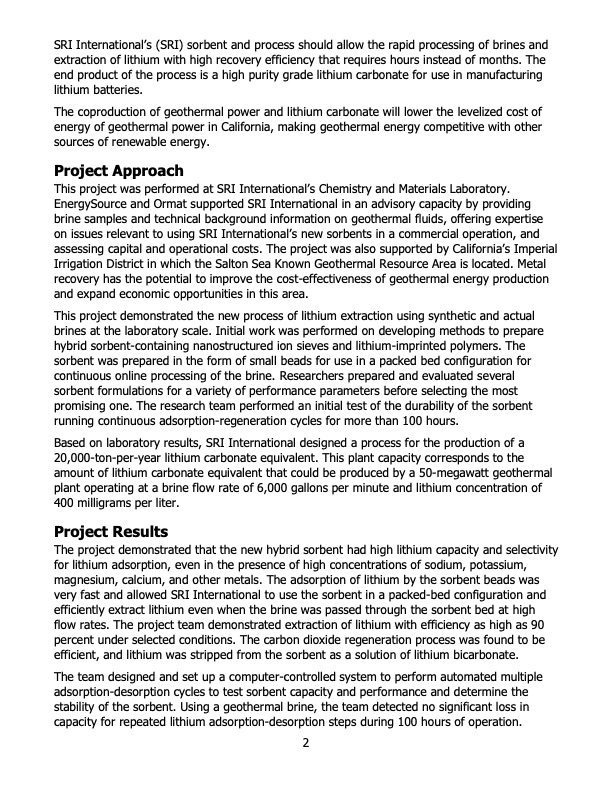
PDF Publication Title:
Text from PDF Page: 010
SRI International’s (SRI) sorbent and process should allow the rapid processing of brines and extraction of lithium with high recovery efficiency that requires hours instead of months. The end product of the process is a high purity grade lithium carbonate for use in manufacturing lithium batteries. The coproduction of geothermal power and lithium carbonate will lower the levelized cost of energy of geothermal power in California, making geothermal energy competitive with other sources of renewable energy. Project Approach This project was performed at SRI International’s Chemistry and Materials Laboratory. EnergySource and Ormat supported SRI International in an advisory capacity by providing brine samples and technical background information on geothermal fluids, offering expertise on issues relevant to using SRI International’s new sorbents in a commercial operation, and assessing capital and operational costs. The project was also supported by California’s Imperial Irrigation District in which the Salton Sea Known Geothermal Resource Area is located. Metal recovery has the potential to improve the cost-effectiveness of geothermal energy production and expand economic opportunities in this area. This project demonstrated the new process of lithium extraction using synthetic and actual brines at the laboratory scale. Initial work was performed on developing methods to prepare hybrid sorbent-containing nanostructured ion sieves and lithium-imprinted polymers. The sorbent was prepared in the form of small beads for use in a packed bed configuration for continuous online processing of the brine. Researchers prepared and evaluated several sorbent formulations for a variety of performance parameters before selecting the most promising one. The research team performed an initial test of the durability of the sorbent running continuous adsorption-regeneration cycles for more than 100 hours. Based on laboratory results, SRI International designed a process for the production of a 20,000-ton-per-year lithium carbonate equivalent. This plant capacity corresponds to the amount of lithium carbonate equivalent that could be produced by a 50-megawatt geothermal plant operating at a brine flow rate of 6,000 gallons per minute and lithium concentration of 400 milligrams per liter. Project Results The project demonstrated that the new hybrid sorbent had high lithium capacity and selectivity for lithium adsorption, even in the presence of high concentrations of sodium, potassium, magnesium, calcium, and other metals. The adsorption of lithium by the sorbent beads was very fast and allowed SRI International to use the sorbent in a packed-bed configuration and efficiently extract lithium even when the brine was passed through the sorbent bed at high flow rates. The project team demonstrated extraction of lithium with efficiency as high as 90 percent under selected conditions. The carbon dioxide regeneration process was found to be efficient, and lithium was stripped from the sorbent as a solution of lithium bicarbonate. The team designed and set up a computer-controlled system to perform automated multiple adsorption-desorption cycles to test sorbent capacity and performance and determine the stability of the sorbent. Using a geothermal brine, the team detected no significant loss in capacity for repeated lithium adsorption-desorption steps during 100 hours of operation. 2PDF Image | Selective Recovery of Lithium from Geothermal Brines

PDF Search Title:
Selective Recovery of Lithium from Geothermal BrinesOriginal File Name Searched:
CEC-500-2020-020.pdfDIY PDF Search: Google It | Yahoo | Bing
Product and Development Focus for Infinity Turbine
ORC Waste Heat Turbine and ORC System Build Plans: All turbine plans are $10,000 each. This allows you to build a system and then consider licensing for production after you have completed and tested a unit.Redox Flow Battery Technology: With the advent of the new USA tax credits for producing and selling batteries ($35/kW) we are focussing on a simple flow battery using shipping containers as the modular electrolyte storage units with tax credits up to $140,000 per system. Our main focus is on the salt battery. This battery can be used for both thermal and electrical storage applications. We call it the Cogeneration Battery or Cogen Battery. One project is converting salt (brine) based water conditioners to simultaneously produce power. In addition, there are many opportunities to extract Lithium from brine (salt lakes, groundwater, and producer water).Salt water or brine are huge sources for lithium. Most of the worlds lithium is acquired from a brine source. It's even in seawater in a low concentration. Brine is also a byproduct of huge powerplants, which can now use that as an electrolyte and a huge flow battery (which allows storage at the source).We welcome any business and equipment inquiries, as well as licensing our turbines for manufacturing.| CONTACT TEL: 608-238-6001 Email: greg@infinityturbine.com | RSS | AMP |